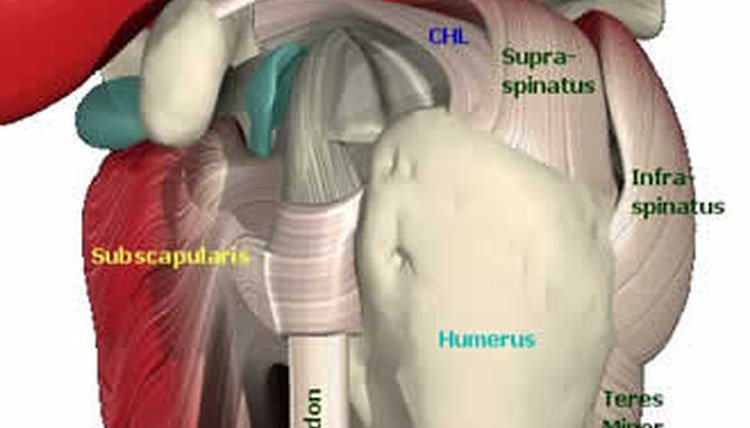Exercises for Rotator Cuff Tendinitis

The rotator cuff is where four groups of tendons form a cap at the top of the humerus bone. This area can become inflamed due to loose joints, overuse or heavy lifting. There are a number of stretching and strength-building exercises that help heal tendinitis in this area. It is best to start slowly and gradually build up strength.
Warm-up and Stretching Exercises
Stretching and warming up the rotator cuff area can promote blood flow to the area and enhance the healing process. Following are several exercises to get the rotator cuff loosened up.
Shoulder Blade Squeeze: Standing or sitting, raise both arms up as if you are forming a football goal post. The arms should be parallel to the floor with the elbows bent at 90 degrees. With your palms facing forward, slowly pull both arms back and squeeze the shoulder blades. Bring the arms forward and together in front of you. Repeat 10 times. This stretches the rhomboid muscle which supports the shoulder. It is important to stretch and build strength in adjacent muscles. It helps to stabilize the shoulder.
Shoulder Roll: While standing or seated, roll both shoulders forward, then shrug the shoulders and squeeze them at the top. Next, pull them backward then lower them, stretching them during each movement. Repeat 5 times.
Shoulder Swing: Bend forward at the waist, and allow your arms to relax and swing freely for a minute. Move them in small circles in front of you. Using just your shoulders, lift the arms up 3 inches and keep the same motion. Try moving them up another 3 inches. Keep doing this exercise under your arms start to feel tired.
These exercises can be performed almost every day. Always ice the affected area after each exercise session, including those that follow.
Dumbbell Exercises
These exercises will help you build rotator cuff strength, which will help heal the tendinitis. Do not do an exercise if you experience any sharp pain. Limit these exercises to twice per week.
Side-Lying External Rotation: Lie on your side on a mat or bench. Hold a light dumbbell in front of your body. Keeping your upper arm and elbow pressed against your side, slowly raise the weight up in a clockwise position, then lower it back down. Do 10 repetitions with each arm.
Face-Down External Rotation: Lie face down on a bench, allowing your face to hang over the edge. Grab two dumbbells. Bend your elbows at 90 degrees. Again, keeping your arm and elbow against your side, lift the dumbbells up from the floor with just the forearms, then lower them back down beneath the bench. One alternative for this exercise is to lower the weight as slowly as you can. Try 10 repetitions.
Seated External Rotations: Sit on a bench and place the dumbbells in front of you with your elbows extended outward. Your arms should be parallel to the floor with your palms facing down. Using the same forearm rotation, slowly bring the weight up and backward until they are over your shoulders. The dumbbells should end up next to your head and slightly above ear level. Lower the weight in front of you, then repeat the motion for 10 repetitions. The entire movement should be about 90 degrees.
Standing External Rotation: With your arm and elbow against your side at a right angle, rotate one elbow outward with the dumbbell, then return to the start position. Do 10 repetitions with each arm.
Other Exercises
Wall Push-ups: Stand about 18 inches from the wall. Lean forward and place your hands on it about shoulder-width apart. Inhale, and slowly lower yourself to the wall, then exhale and push yourself back up. Wall push-ups are easier on the rotator cuff than regular push-ups. Try to eventually add more resistance as your injury heals. This can be done by pushing off lower surfaces such as as dresser or table.
Stretch Band Exercise: Tie the band to a doorknob. Grab the other end and stand several feet away. Keeping your arm next to your body and elbow bent at 90 degrees, slowly pull the band toward you, then away from your body. Try 10 repetitions with each arm.
